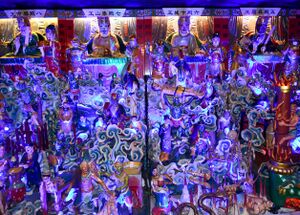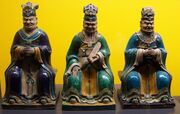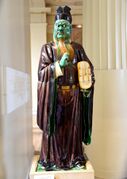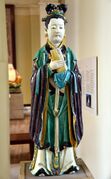Unsolved:Diyu
| Diyu |
|---|
Diyu (simplified Chinese: 地狱; traditional Chinese: 地獄; pinyin: dìyù; literally: 'earth prison') is the realm of the dead or "hell" in Chinese mythology. It is loosely based on a combination of the Buddhist concept of Naraka, traditional Chinese beliefs about the afterlife, and a variety of popular expansions and reinterpretations of these two traditions. The concept parallels purgatory in certain Christian denomininations.
Diyu is typically depicted as a subterranean maze with various levels and chambers, to which souls are taken after death to atone for the sins they committed when they were alive. The exact number of levels in Diyu and their associated deities differ between Buddhist and Taoist interpretations. Some speak of three to four "courts"; others mention "Ten Courts of Hell", each of which is ruled by a judge (collectively known as the Ten Yama Kings); other Chinese legends speak of the "Eighteen Levels of Hell". Each court deals with a different aspect of atonement and different punishments; most legends claim that sinners are subjected to gruesome tortures until their "deaths", after which they are restored to their original state for the torture to be repeated.
Alternative names
- Difu (Chinese: 地府; pinyin: Dìfǔ; Wade–Giles: Ti4-fu3), "Earth Mansion".
- Huangquan (黄泉; 黃泉; Huángquán; Huang2-ch'üan2), "Yellow Springs".
- Yinjian (阴间; 陰間; Yīnjiān; Yin1-chien1; 'Yin dimension'), "Land of Shade".
- Yinfu (阴府; 陰府; Yīnfǔ; Yin1-fu3), "Shady Mansion".
- Yinsi (阴司; 陰司; Yīnsī; Yin1-szu1), "Shady Office".
- Senluo Dian (森罗殿; 森羅殿; Sēnluódiàn; Sen1-lo2 Tien4), "Court of Senluo".
- Yanluo Dian (阎罗殿; 閻羅殿; Yánluódiàn; Yan2-lo2 Tien4), "Court of Yanluo".
- Jiuquan (九泉; Jiǔquán; Chiu3-ch'üan2), "Nine Springs".
- Zhongquan (重泉; Zhòngquán; Chung4-ch'üan2), "Heavy Spring".
- Quanlu (泉路; Quánlù; Ch'üan2-lu4), "Road to the Spring".
- Youming (幽冥; Yōumíng; Yu1-ming2), "Serene Darkness".
- Yourang (幽壤; Yōurǎng; Yu1-jang3), "Serene Land".
- Huokang (火炕; Huǒkàng; Huo3-kang4), "Fire Pit".
- Jiuyou (九幽; Jiǔyōu; Chiu3-yu1), "Nine Serenities".
- Jiuyuan (九原; Jiǔyuán; Chiu3-yüan2), "Nine Origins".
- Mingfu (冥府; Míngfǔ; Ming2-fu3), "Dark Mansion".
- Mingjie (冥界; Míngjiè; Ming2-chieh4), "Dark Realm", "Underworld".
- Kujing (苦境; Kǔjìng; K`u3-ching4), "Dire Straits", "(Place of) Grievance".
- Abi (阿鼻; Ābí; A1-pi2), "Avīci", the hell of uninterrupted torture, last and deepest of the Eight Hot Narakas.
- Zugen (足跟; Zúgēn; Tsu2-ken1), "Heel".
- Fengdu Cheng (丰都城; 酆都城; Fēngdū Chéng; Feng1-tu1 Ch'eng2), a reference to the Fengdu Ghost City.
Conceptions
According to ideas from Taoism,[citation needed] Buddhism[1][2][3] and traditional Chinese folk religion, Diyu is a purgatory that serves to punish and renew spirits in preparation for reincarnation. Many deities, whose names and purposes are the subject of conflicting accounts, are associated with Diyu.
Some early Chinese societies speak of people going to Mount Tai, Jiuyuan, Jiuquan or Fengdu after death.[4][5] At present, Fengdu and the temples on Mount Tai have been rebuilt into tourist attractions, incorporating artistic depictions of hell and the afterlife.[citation needed] Some Chinese folk religion planchette writings, such as the Taiwanese novel Journeys to the Under-World, say that new hells with new punishments are created as the world changes and that there is a City of Innocent Deaths (枉死城) designed to house those who died with grievances that have yet to be redressed.[6]
Other terminology related to Diyu includes:
- Naihe Bridge (奈何桥; 奈何橋; Nàihé Qiáo; Nai4-ho2 Ch'iao2), "Bridge of Helplessness", a bridge every soul has to cross before being reincarnated, they are said to drink the Mengpo soup (孟婆汤) at Naihe Qiao so they will forget everything in their current lives and prepare for reincarnation.
- Wang Xiang Tai (望乡台; 望鄉臺; Wàng Xiāng Tái; Wang4 Hsiang1 T'ai2), "Home-Viewing Pavilion", a pavilion every soul passes by on his/her journey to the Underworld. From there, they can see their families and loved ones in the world of the living.
- Youdu (Chinese: 幽都; pinyin: Yōu Dū; Wade–Giles: You1-du1), the capital city of Diyu, generally conceived as being similar to a typical Chinese capital city, such as Chang'an, but surrounded by and pervaded with darkness.
- Youguo (油锅; 油鍋; Yóu Guō; You2-kuo1), "Oil Cauldron", one of the tortures in hell.
- Santu (三涂; 三塗; Sān Tú; San1-t'u2), the "Three Tortures": Fire Torture (火涂; 火塗; Huǒ Tú; Huo3-t'u2), Blade Torture (刀涂; 刀塗; Dāo Tú; Tao1-t'u2), Blood Torture (血涂; 血塗; Xuě Tú; Hsüeh3-t'u2; 'spilling of blood').
Ten Courts of Yanluo
The concept of the "Ten Courts of Yanluo" (十殿閻羅) began after Chinese folk religion was influenced by Buddhism. In this variation of Chinese mythology, there are 12,800 hells located under the earth – eight dark hells, eight cold hells and 84,000 miscellaneous hells located at the edge of the universe. All will go to Diyu after death but the period of time one spends in Diyu is not forever – it depends on the severity of the sins one committed. After receiving due punishment, one will eventually be sent for reincarnation. Diyu is divided into ten courts, each overseen by a Yanwang. Souls pass from stage to stage at the decision of a different judge. The "Ten Courts of Yanluo" is also known as the Ten Courts of Yanwang (十殿阎王), Ten Lords of Minggong (冥宫十王), Ten Courts of Yan-jun (十殿阎君), Ten-Lords of Difu (地府十王), and Ten-Lords of Mingfu (冥府十王).
| # | Title | Family name | Chinese calendar Birthday |
In charge of (see the Cold and Hot Narakas for details) |
Notes |
|---|---|---|---|---|---|
| 1 | King Qin'guang 秦廣王 |
Jiang 蔣 |
1st day, 2nd month |
Life and death and fortunes of all humans | Believed to be Jiang Ziwen |
| 2 | King Chujiang 楚江王 |
Li 歷 |
1st day, 3rd month |
Sañjīva, Arbuda | |
| 3 | King Songdi 宋帝王 |
Yu 余 |
8th day, 2nd month |
Kālasūtra, Nirarbuda | |
| 4 | King Wuguan 五官王 |
Lü 呂 |
18th, 2nd month |
Saṃghāta, Aṭaṭa | |
| 5 | King Yanluo 閻羅王 |
Bao 包 |
8th, 1st month |
Raurava, Hahava | Believed to be Bao Zheng |
| 6 | King Biancheng 卞城王 |
Bi 畢 |
8th day, 3rd month |
Mahāraurava, Huhuva, and City of Innocent Deaths | |
| 7 | King Taishan 泰山王 |
Dong 董 |
27th day, 3rd month |
Tapana, Utpala | |
| 8 | King Dushi 都市王 |
Huang 黃 |
1st day, 4th month |
Pratāpana, Padma | |
| 9 | King Pingdeng 平等王 |
Lu 陸 |
8th day, 4th month |
Avīci, Mahāpadma | |
| 10 | King Zhuanlun 轉輪王 |
Xue 薛 |
17th day, 4th month |
Sending souls for reincarnation |
Entrance to the "Ten Courts of Hell" attraction in Haw Par Villa, Singapore. The Ox-Headed (right) and Horse-Faced (left) Hell Guards stand guard at the entrance.
Eighteen levels of Hell
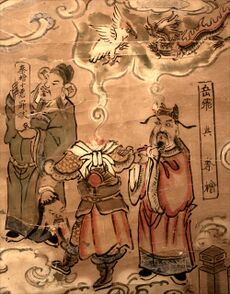
The concept of the eighteen hells started in the Tang dynasty. The Buddhist text Sutra on Questions about Hell (問地獄經) mentioned 134 worlds of hell, but was simplified to the Eighteen Levels of Hell in the Sutra on the Eighteen Hells (十八泥犁經) for convenience. Some literature refers to eighteen types of hells or to eighteen hells for each type of punishment.
Some religious or literature books say that wrongdoers who were not punished when they were alive are punished in the hells after death. Sinners feel pain and agony just like living humans when they are subjected to the tortures listed below. They cannot "die" from the torture because when the ordeal is over, their bodies will be restored to their original states for the torture to be repeated.[7][8][9][10][11][12]
The eighteen hells vary from narrative to narrative but some commonly mentioned tortures include: being steamed; being fried in oil cauldrons; being sawed into half; being run over by vehicles; being pounded in a mortar and pestle; being ground in a mill; being crushed by boulders; being made to shed blood by climbing trees or mountains of knives; having sharp objects driven into their bodies; having hooks pierced into their bodies and being hung upside down; drowning in a pool of filthy blood; being left naked in the freezing cold; being set aflame or cast into infernos; being tied naked to a bronze cylinder with a fire lit at its base; being forced to consume boiling liquids; tongue ripping; eye gouging; teeth extraction; heart digging; disembowelment; skinning; being trampled, gored, mauled, eaten, stung, bitten, pecked, etc., by animals.
| # | Version 1 | Version 2 | As mentioned in Journey to the West |
|---|---|---|---|
| 1 | Hell of Tongue Ripping 拔舌地獄 |
Naraka Hell 泥犁地獄 |
Hell of Hanging Bars 吊筋獄 |
| 2 | Hell of Scissors 剪刀地獄 |
Hell of the Mountain of Knives 刀山地獄 |
Hell of the Wrongful Dead 幽枉獄 |
| 3 | Hell of Trees of Knives 鐵樹地獄 |
Hell of Boiling Sand 沸沙地獄 |
Hell of the Pit of Fire 火坑獄 |
| 4 | Hell of Mirrors of Retribution 孽镜地狱 |
Hell of Boiling Faeces 沸屎地獄 |
Fengdu Hell 酆都獄 |
| 5 | Hell of Steaming 蒸籠地獄 |
Hell of Darkened Bodies 黑身地獄 |
Hell of Tongue Ripping 拔舌獄 |
| 6 | Hell of Copper Pillars 銅柱地獄 |
Hell of Fiery Chariots 火車地獄 |
Hell of Skinning 剝皮獄 |
| 7 | Hell of the Mountain of Knives 刀山地獄 |
Hell of Cauldrons 鑊湯地獄 |
Hell of Grinding 磨捱獄 |
| 8 | Hell of the Mountain of Ice 冰山地獄 |
Hell of Iron Beds 鐵床地獄 |
Hell of Pounding 碓搗獄 |
| 9 | Hell of Oil Cauldrons 油鍋地獄 |
Hell of Cover Mountains 蓋山地獄 |
Hell of Dismemberment by Vehicles 車崩獄 |
| 10 | Hell of the Pit of Cattle 牛坑地獄 |
Hell of Ice 寒冰地獄 |
Hell of Ice 寒冰獄 |
| 11 | Hell of Boulder Crushing 石壓地獄 |
Hell of Skinning 剝皮地獄 |
Hell of Moulting 脫殼獄 |
| 12 | Hell of Mortars and Pestles 舂臼地獄 |
Hell of Beasts 畜生地獄 |
Hell of Disembowelment 抽腸獄 |
| 13 | Hell of the Pool of Blood 血池地獄 |
Hell of Weapons 刀兵地獄 |
Hell of Oil Cauldrons 油鍋獄 |
| 14 | Hell of the Wrongful Dead 枉死地獄 |
Hell of Iron Mills 鐵磨地獄 |
Hell of Darkness 黑暗獄 |
| 15 | Hell of Dismemberment 磔刑地獄 |
Hell of Dismemberment 磔刑地獄 |
Hell of the Mountain of Knives 刀山獄 |
| 16 | Hell of the Mountain of Fire 火山地獄 |
Hell of Iron Books 鐵冊地獄 |
Hell of the Pool of Blood 血池獄 |
| 17 | Hell of Mills 石磨地獄 |
Hell of Maggots 蛆蟲地獄 |
Avīci Hell 阿鼻獄 |
| 18 | Hell of Sawing 刀鋸地獄 |
Hell of Molten Copper 烊銅地獄 |
Hell of Weighing Scales 秤桿獄 |
See also
- Chinese mythological geography
- Naraka (Buddhism), the Buddhist concept of Hell which is related to the Chinese concept of Diyu
- Yama (East Asia), the wrathful deity who rules Hell in Buddhist mythology
- Ksitigarbha, a bodhisattva who vowed never to achieve buddhahood until the hells are emptied
- Maudgalyayana, one of the Buddha's disciples and the protagonist of the Chinese tale Mulian Rescues His Mother
- Meng Po, a deity who serves souls a potion that makes them forget their past lives before they go for reincarnation.She awaits the dead souls at the entrance of the 9th round Fengdu.
- Ox-Head and Horse-Face, hell guards in Chinese mythology
- Heibai Wuchang, hell guards in Chinese mythology
- Ghost Festival, a traditional Buddhist and Taoist festival celebrated in some Asian countries
- Hell money, joss paper designed to resemble banknotes and meant to be burnt as offerings to the dead
- Hell Scroll (Nara National Museum), a Japanese scroll depicting hells, kept at the Nara National Museum
- Journeys to the Under-World, a Taiwanese novel narrating a journey through Diyu
References
- ↑ "Error: no
|title=specified when using {{Cite web}}" (in zh). http://read.goodweb.cn/dyjy/. - ↑ 萧登福 [Xiao, Dengfu] (August 1988). (in zh)东方杂志 [Eastern Magazine] 22 (2): 34–40. http://www.wuys.com/news/Article_Show.asp?ArticleID=6888. Retrieved 8 January 2015.
- ↑ 萧登福 [Xiao, Dengfu] (August 1988). (in zh)东方杂志 [Eastern Magazine] 22 (3): 23–30. http://www.wuys.com/news/Article_Show.asp?ArticleID=6889. Retrieved 8 January 2015.
- ↑ "Error: no
|title=specified when using {{Cite web}}" (in zh). http://www.yinshun.org.tw/books/28/yinshun28-05.html#H2. - ↑ "Error: no
|title=specified when using {{Cite web}}" (in zh). 3 March 2008. http://www.taishanly.com/Article/zongjiao/shenzhi/200803/5390.html. - ↑ "Error: no
|title=specified when using {{Cite web}}" (in zh). http://tienton.myweb.hinet.net/poordie.htm. - ↑ Xue, Fucheng. Yong'an Biji (Notebook of Yong An).
- ↑ "Error: no
|title=specified when using {{Cite web}}" (in zh). http://xn--1qq22qc0dpvm9wk.net/%E5%9B%A0%E6%9E%9C%E6%84%9F%E6%87%89%E4%BA%8B%E8%B9%9F/%E7%80%95%E6%AD%BB%E9%AB%94%E9%A9%97/D%E7%80%95%E6%AD%BB%E9%AB%94%E9%A9%971.htm. - ↑ "Error: no
|title=specified when using {{Cite web}}" (in zh). http://public.dha.ac.cn/content.aspx?id=301052650440. - ↑ 潘重規 [Pan, Chonggui] (1994) (in zh). Dunhuang Bian Wenji Xinshu. China: 文津出版社 [Wen Jin Publishing House]. http://www.eywedu.com/dunhuang/078.htm. Retrieved 8 January 2015.
- ↑ 黎澍 [Li, Shu] (March 2006) (in zh) (3rd ed.). Taipei: 淨土宗文教基金會 [Pure Land Sect Foundation]. http://www.pureland-buddhism.org/%E6%B7%A8%E5%9C%9F%E5%AE%97%E5%8F%A2%E6%9B%B8/%E5%9C%B0%E7%8D%84%E8%A6%8B%E8%81%9E%E9%8C%84/. Retrieved 8 January 2015.
- ↑ 泰国上校真实因果轮回见证
External links
- "Error: no
|title=specified when using {{Cite web}}" (in zh). 12 July 2005. http://big5.xinhuanet.com/gate/big5/news.xinhuanet.com/school/2005-07/12/content_3202514.htm. - "Error: no
|title=specified when using {{Cite web}}" (in zh). College of Liberal Arts, Digital Library & Museum of Buddhist Studies. http://ccbs.ntu.edu.tw/BDLM/sutra/chi_pdf/sutra9/T17n0731.pdf.
 |

